Gymnosperms are Seed Plants | Cycads | Ginkgos | Conifers | Gnetales
Angiosperms are Flowering Plants | Flowers | Trends in Plant Evolution | Links
Gymnosperms have seeds but not fruits or flowers. Gymnos means naked, sperm means seed: gymnosperm = naked seeds. Gymnosperms developed during the Paleozoic Era and became dominant during the early Mesozoic Era. There are 700 living species placed into four divisions: conifers, cycads, ginkgos, and gnetales (such as Ephedra).
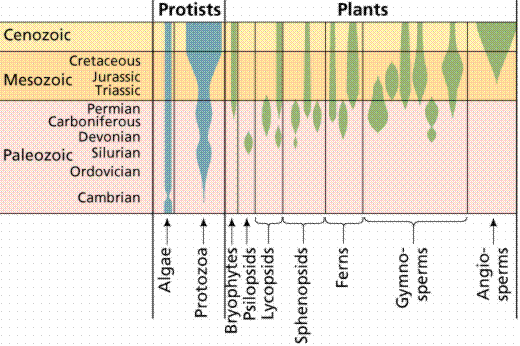
The fossil records of some protist and plant groups. The width of the shaded space is an indicator of the number of species. Image from W.H. Freeman and Sinauer Associates, used by permission.
Gymnosperms are undoubtedly the group from which the angiosperms developed, although, as Charles Darwin noted in Origin of Species, which group "remains an abominable mystery".
Cycads retain some fern-like features, notably pinnate leaves and circinate vernation. However, they (usually) produce cones of nonphotosynthetic reproductive structures. These cones are unisexual, in fact the plants are dioecious, having separate male and female plants. Cycads were much more prominent in the forsts of the Mesozoic than they are today. Presently, they are restricted to the tropics. Zamia floridana is the only cycad occurring natively in the continental United States. Several species of Cycas, notably C. revoluta, are commonly encountered cultivated plants in warm, moist areas. Cycas revoluta leaves are often used in Palm Sunday services.

Cycas revoluta from Hawaii, showing female cones bearing large, orange seeds. Image from http://www.botany.hawaii.edu/faculty/carr/images/cyc_rev_f.jpg.
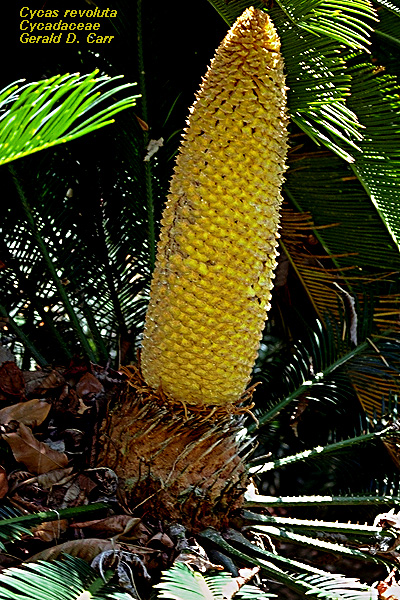
Cycas revoluta from Hawaii, showing the male cone bearing numerous pollen-producing sporangia. Image from http://www.botany.hawaii.edu/faculty/carr/images/cyc_rev_m.jpg.
The ginkgos also were a much more prominent group in the past than they are today. The sole survivor of this once robust and diverse group is Ginkgo biloba, the maidenhair tree. Extensively used as an ornamental plant, Ginkgo was thought extinct in the wild until it was discovered growing natively in a remote area of China. Ginkos are dioecious, with separate male and female plants. The males are more commonly planted since the females produce seeds that have a nasty odor. Pollination is by wind. Recently, Ginkgo has become the current herbal rave.
The conifers remain a major group of gymnosperms that include the pines, spruce, fir, bald cypress and Norfolk Island Pine (Araucaria).
Pines
Auracarias
Members of this group of conifers have numerous small, scale-like leaves spiralling around their stems. Araucaria, a major genus that gives its name to the group, is a common ornamental because of the symmetry and beauty of its growth form. The monkey puzzle tree is a species of Araucaria.

Image of Araucaria sp. Note the large female comes at the tips of branches. Image from http://www.botany.hawaii.edu/faculty/carr/images/araucar_sp3.jpg.
Taxodiaceae: Sequoias and more
Members of this group include some of the largest trees, and have been significant members of the forests of the world since the Mesozoic. Sequoia and Sequoiadendron are major genera in this group.

Habit photograph of Sequoia sempervirens. Note the tall, woody stem with leaves borne at the top of the stem. Image from http://www.botany.hawaii.edu/faculty/carr/images/seq_sem_hab.jpg.

Closeup of Sequoia sempervirens leaf and cone. Image from http://www.botany.hawaii.edu/faculty/carr/images/seq_sem_cu.jpg.
The Pine Life Cycle
Pollen grains contain the male gametophyte (reduced to a very few cells). Pollen is released and carried by wind to the female cone, where it lands and germinates to produce a pollen tube that grows into the female gametophyte. The sperm cell and egg cell fuse, forming the next generation sporophyte. The sporophyte develops into an embryo encased in a seed. The seed is later released to be transported by the wind to where (hopefully) it lands and germinates. .
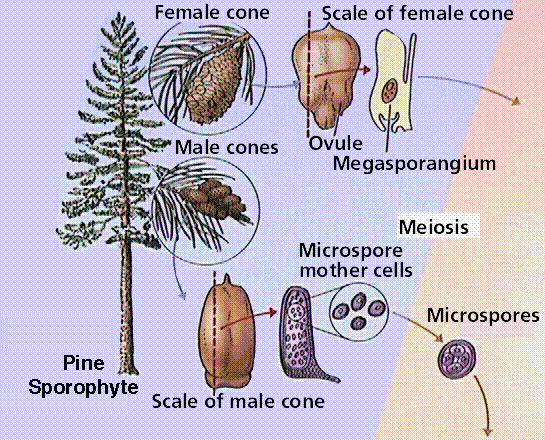
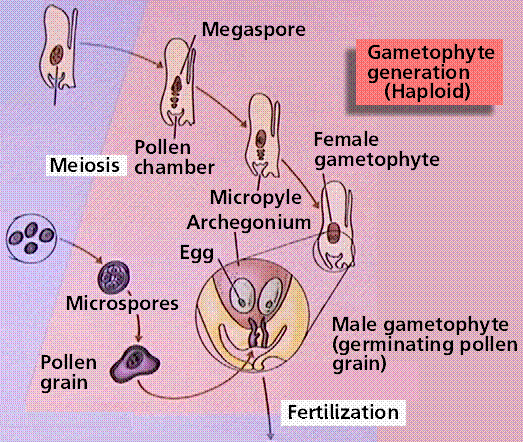


The pine life cycle. Note: to view these four segments in correct sequence you will need to increase your browser window width as much as possible.
The Gnetales are an odd group: they have some angiosperm-like features but are not themselves angiosperms. Cladistic analyses support placement of the gtnetales (or some portion of them) as outgroups for the flowering plants. Three distinctive genera comprise this group: Welwitschia, Gnetum, and Ephedra. Ephedra occurs in the western United States where it has the common name "Mormon tea". It is a natural source for the chemical ephedrine, although there is no evidence the Mormons in Utah (where the plant is extremely common) ever used it for tea. Welwitschia is limited to coastal deserts in Southe Africa, although fossil leaf, cuticle and pollen evidence indicates plants of this type were widespread during the Mesozoic Era. Welwitschia is noted for its two long, prominent leaves. Gnetum has leaves that look remarkably like those in angiosperms, as well as vessels in the xylem, generally considered an angiosperm characteristic.

Ephedra female plant. Image from http://www.botany.hawaii.edu/faculty/carr/images/eph_sp_f.jpg.
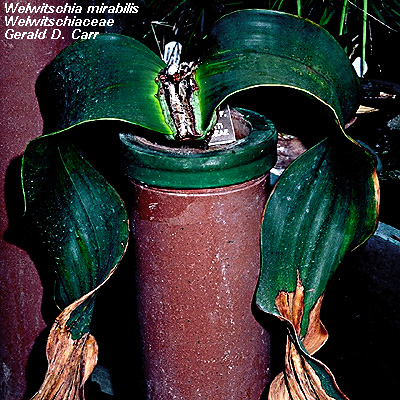
Welwitschia mirabilis habit shot of a cultivated specimen. Image from http://www.botany.hawaii.edu/faculty/carr/images/wel_mir.jpg.
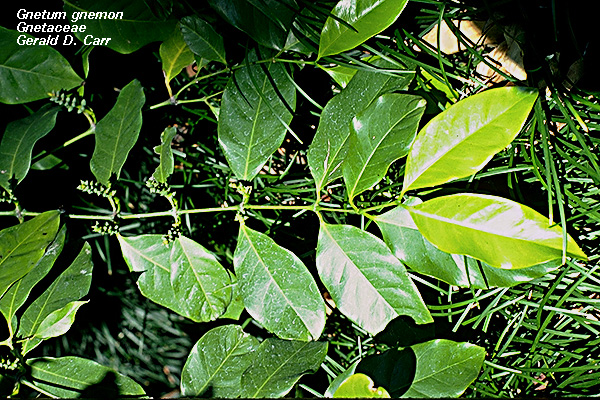
Gnetum gnemon habit shot showing pinnate leaves bearing female strobili. Image from http://www.botany.hawaii.edu/faculty/carr/images/gne_gne.jpg.
Flowering plants, the angiosperms, were the last of the seed plant groups to evolve, appearing over 140 million years ago during the later part of the of the Age of Dinosaurs (the beginning of the Cretaceous, 140 million years ago). All flowering plants produce flowers. Within the female parts of the flower angiosperms produce a diploid zygote and triploid endosperm. Fertilization is accomplished by a variety of pollinators, including wind, animals, and water. Two sperm are released into the female gametophyte: one fuses with the egg to produce the zygote, the other helps form the nutritive tissue known as endosperm.
The angiosperms (angios = hidden) produce modified leaves grouped into flowers that in turn develop fruits and seeds. There are presently 235,000 known living species. Most angiosperms also have larger xylem cells known as vessels that improve the efficiency of their vascular systems.
Whence came the angiosperms? This was Darwin's "abominable mystery". Clearly angiosperms are descended from some group of Mesozoic-aged gymnosperm seed plant....but which one? Click here to view an online lab exercise in phylogeny and try to figure things out!
The classical view of flowering plant evolution suggests early angiosperms were evergreen trees that produced large Magnolia-like flowers. Click here to view an illustration of suggested paths of floral evolution. However, this view has recently been contradicted by the oldest fossil yet found, a 140 million year old plant found by David Dilcher and his associates.
The angiosperms underwent an adaptive radiation during the Cretaceous, and for the most part escaped the major extinctions at the end of the Cretaceous.
Flowers are collections of reproductive and sterile tissue arranged in a tight whorled array having very short internodes. Sterile parts of flowers are the sepals and petals. When these are similar in size and shape, they are termed tepals. Reproductive parts of the flower are the stamen (male, collectively termed the androecium) and carpel (often the carpel is referred to as the pistil, the female parts collectively termed the gynoecium).
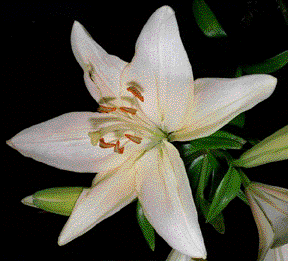
The above image is reduced from gopher://wiscinfo.wisc.edu:2070/I9/.image/.bot/.130/Angiosperm/Lilium/Flower_dissection/Flower. Follow that link to view a larger image of this flower of Lilium (lily).
Flowers may be complete, where all parts of the flower are present and functional, or incomplete, where one or more parts of the flower are absent. Many angiosperms produce a single flower on the tip of a shoot (like the Lily pictured above). Others produce a stalk bearing numerous flowers, termed an inflorescence. Many flowers show adaptations for insect pollination, bearing numerous white or yellow petals. Others, like the grasses, oaks, and elms, are wind pollinated and have their petals reduced and often inconspicuous.
Angiosperm Life Cycle
Flowering plants also exhibit the typical plant alternation of generations. The dominant phase is the sporophyte, with the gametophyte being much reduced in size and wholly dependant on the sporopohyte for nutrition. The is not a unique angiosperm condition, but occurs in all seed plants as well. What makes the angiosperms unique is their flowers and the "double fertilization" that occurs. Technically this is not double fertilization, but rather a single egg-sperm fusion (fertilization proper) plus a fusion of the second of two sperm cells with two haploid cells in the female gametophyte to p[roduce triploid (3n) endosperm, a nutritive tissue for the developing embryo. More details on this aspect of the flowering plants are available in the FLOWERING PLANT REPRODUCTION: Fertilization and Fruits chapter.

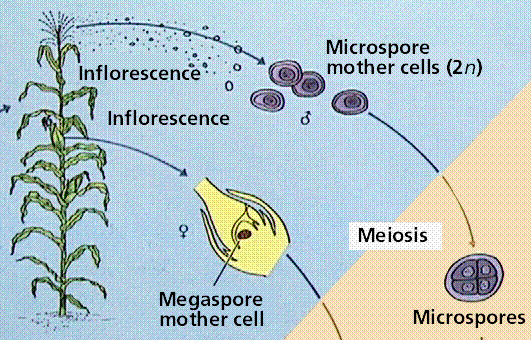
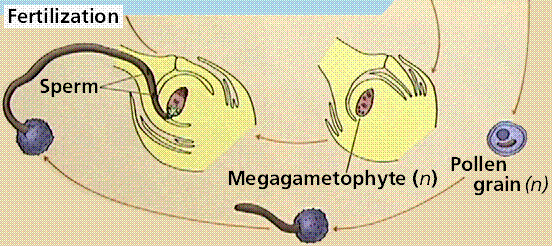
Life cycle of corn, a typical monocot angiosperm. Note the formation of endosperm by "double fertilization".
Developing from green algal ancestors, plants show a trend for reduction of the complexity, size, and dominance of the gametophyte generation. Plants also developed and refined the root-shoot-leaf axis with its specialized conduction cells. A third trend is the development of the seed to promote the dormancy of the embryo.
Email: mj.farabee@emcmail.maricopa.edu![]()
Last modified:
2000/01/05:13:24:51
The URL of this page is:
gened.emc.maricopa.edu/bio/BIO181/BIOBK/BioBookDiversity_6.html